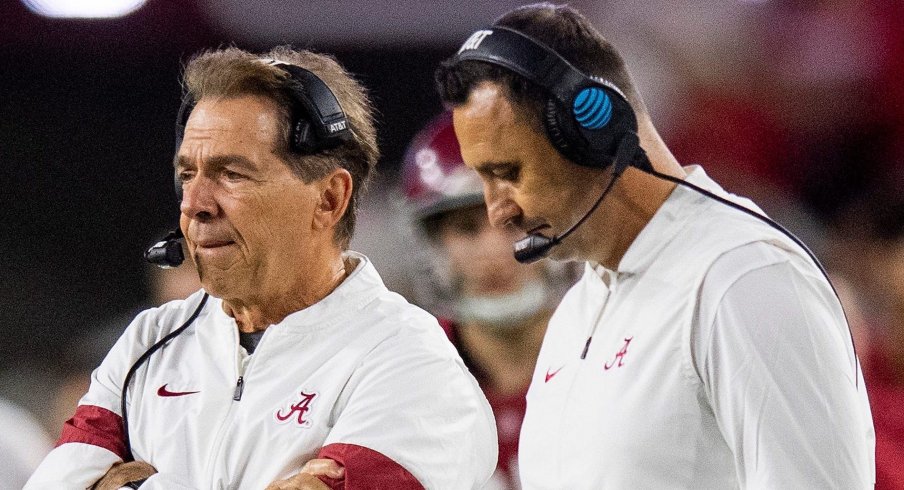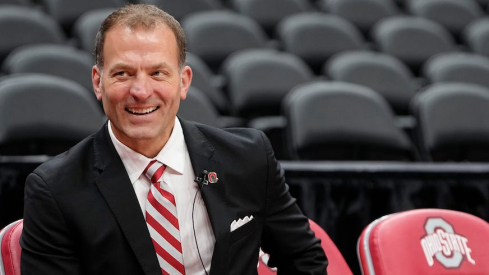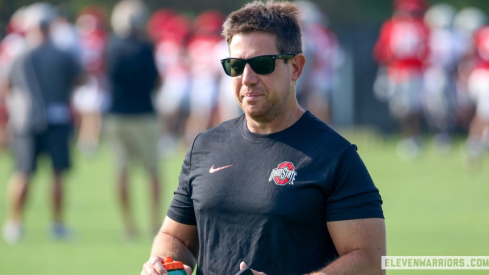Nick Saban may be the greatest defensive coach in college football history, but his team is playing for a national championship because of its offense.
In 2012, when the Spread Offense revolution was all but imminent, the Alabama head coach seemed to draw a final line in the sand. Despite surrendering just 218 yards and 14 points in a dominant win over Hugh Freeze's uptempo, no-huddle Ole Miss offense, the king of the sport famously decried such tactics, making waves in the process.
Eight years later and still in command of the Tuscaloosa Death Star, those same comments look downright comical. Though the Crimson Tide still features one of the best defenses in the Southeastern Conference, Saban is one win away from his seventh national championship thanks to an explosive offense averaging 7.84 yards-per-play - the best mark in the nation.
People love to mockingly bring up Sabans Is this what we want football to be? line like he was complaining. He was just asking yall to choose the form of your destructor.
— Matt Scalici (@MattScalici) October 18, 2020
Outside of the John Mackey Award, which went to Florida's Kyle Pitts, the Crimson Tide swept every other national offensive honor. Even the Joe Moore Award, given to the nation's best offensive line, announced Alabama as its winner this season.
No team in America scored more points than Saban's squad, who have averaged 48.2 per game this season. Of 135 total possessions so far this year, 90 have resulted in points for the Crimson Tide.
In the CFP semifinal with Notre Dame, that trend continued. Held to a season-low in points scored, the Tide still racked up 31 points in a game that was never really in doubt.
Like they've done all season, the trio of Heisman-winning receiver Devonta Smith, quarterback Mac Jones, and running back Najee Harris kept the Irish defense on its heels all afternoon in AT&T Stadium. With a deadly collection of Run-Pass Options (RPOs), the 'Bama offense made gaining 437 yards of offense look pedestrian.
For example, at the conclusion of their opening drive, Jones pulled the ball away from Harris as he looked to run a GY Counter concept around the left side, stepping back and hitting Smith on a slant route that went 26 yards for a touchdown.
As offensive coordinator Steve Sarkisian told an audience of coaches at a clinic in Atlanta last winter, this performance was by design:
“We’re an RPO team that runs the football if you’re going to let us run the ball, and we will continue to run the ball. The minute you say, ‘we’re going to take away the run,’ our system is built to throw RPOs.
How do you take away RPOs? You play with leverage in my opinion. You play man, you play with inside leverage, and you take away those throws.
"Alright, so now, what do we do? We have to make you defend throws down the field. So we are going to hard play-pass you and take shots down the field."
As Sarkisian noted, the Tide is more than happy to run the ball down an opponent's throat, leaning on a massive O-line. With Outland winner, Alex Leatherwood at left tackle, Sarkisian likes mixing inside and outside zone with a heavy amount of counter schemes.
Eventually, opponents will add extra bodies to the box and play press-man coverage to slow down quick passes, opening them up to deep, play-action passes that look identical at first to those same RPOs. But for all the talk of the Tide being explosive, few of Jones' passes get thrown very deep.
Of his 379 pass attempts this year, just 53 traveled more than 20 yards downfield in the air. When looking at Smith's production, a similar pattern emerges, as just 25 of his 130 targets came on passes of 20 yards or more this season.
Last season, with a quartet of NFL-caliber wideouts in Smith, Jaylen Waddle, Jerry Jeudy, and Henry Ruggs III, defenses were constantly challenged by a never-ending barrage of slants, quick outs, crossers, and post routes. Now with only Smith healthy, the Tide has turned elsewhere for production in the passing game.
“My opinion," Sarkisian told the same audience of coaches. "The least-defended player on the field in the passing game is the running back.”
Though John Metchie has stepped up in Waddle's absence since the deep threat broke his ankle back in October, Jones' security blanket in the passing game certainly appears to be Harris out of the backfield. The Walker Award-winner added 36 receptions to his 1,387 rushing yards this season, providing Jones with an easy target whenever the QB couldn't find an open receiver downfield.
But Sarkisian's goal is still to create explosive plays like Smith's slant above. To do that, Sarkisian ensures his dynamic playmakers are always catching the ball on the move, rather than sitting still on curl routes.
“I don’t like throwing the ball to a stationary target, because I’m as slow or I’m as fast as Julio Jones at that moment. Let’s get the guys catching the ball on the move, catching the ball running. Let them do what they’re best at.”
In the 2020 season, no one has truly found a way to stop this efficient and explosive unit. As Ohio State's defense prepares for its biggest challenge of the year, Ryan Day and his staff must recognize that the most likely path to victory is by getting just one more stop than the Alabama defense gets against Justin Fields and the Buckeye offense, winning a high-scoring shootout.
Ole Miss famously routed Saban's defense early in the season, tallying 647 yards and 48 points, but gave up 63 points of their own. One week later, Georgia stayed with Alabama until the fourth quarter, holding Sarkisian's offense to a modest 414 yards, but the Bulldogs could only muster 24 points of their own.
Perhaps the most interesting example was Arkansas. Yes, the Razorbacks lost 52-3 in their late-season matchup, but that was due more to turnovers and special teams woes which handed the Tide an early 24-3 lead.
When Jones and co. had the ball, they found it difficult to move it as the Hogs unexpectedly played a 3-2-6 defense, keeping everything in front of them and forcing 'Bama to string together the long drives Sarkisian tries to avoid.
Arkansas' 3-deep, 5-under zone scheme held Harris to just 46 yards on 14 carries while Smith's longest catch of the day was just 10 yards. Clearly, Ohio State isn't going to change its entire defensive structure for one game, but will instead look to adept what the players already know.
Notre Dame found some success by doing the same, forcing three punts and a field goal on eight total Alabama drives. Though trailing 21-7 midway through the second quarter, the Irish may have given the Buckeyes a blueprint for how to stop Sarkisian's devastating offense.
While it doesn't seem to matter where any Alabama drives begin this season, what does matter is how well they stay 'ahead of schedule,' meaning if they pick up four or five yards on first down. The reason being, the threat of an RPO can be ever-present and Jones isn't forced to drop back on 3rd and long.
After allowing Alabama to find the end zone on each of its first three drives, the Notre Dame defense finally got them 'behind schedule' on the fourth, leading to an eventual punt. Here's how they did it:
First Down
The Tide come out in a base, 2x2 formation with the tight end toward the boundary and Smith in the slot. The Irish are in a single-high defense but don't give away whether they're playing man or zone coverage. If it's the former, Jones knows he'll have a numeric advantage with the run and will decide before the snap to hand off to Harris.
Jones often makes such decisions based on the defense's pre-snap alignment, but the Irish have muddied his view and forced him to wait until he has the ball in his hands. As hybrid linebacker/safety Jeremiah Owusu-Koramoah (#6) clamps down immediately on Smith to take away the slant route while the free safety (#14) provides cover over the top, Jones simply gives the ball to Harris to run a GY Counter play.
But the ND defense was prepared for the scheme, recognizing the guard and tight end pulling across the formation, prompting the linebackers and backside safety to follow suit. Their gap responsibilities changed, similar to the way Ohio State defends Split-Zone runs, making a 'fall' call and each bumping their run responsibilities over a gap.
Most importantly, the middle linebacker (#40) gets outside quick enough to contain Harris from bouncing to the edge, pushing him back inside toward a swam of tacklers and only a short gain.
Second Down
Recognizing the defense's plan to take away Smith in the passing game, Sarkisian looked for other ways to get his best player the ball. While screens are his favorite method of doing so (per Pro Football Focus, Smith has caught 34 passes behind the line of scrimmage this season), this time the Alabama play-caller used the same GY Counter scheme as the play prior to set up an end-around.
The strength of Alabama's offensive line is clearly on the edges with Leatherwood (#70) at left tackle and Evan Neal (#73) on the right. But without Rimington winner, Landon Dickerson at center, who went down with a season-ending knee injury in the SEC championship, the interior of the Crimson Tide line hasn't looked the same.
As left guard Deonte Brown (#65) pulled around to lead Smith, the Notre Dame defensive tackle on his outside shoulder darted through the gap he left behind. Chris Owens (#79), a converted tackle starting at center in place of Dickerson, couldn't reach the defender as he exploded into the backfield untouched, immediately giving chase to Smith.
Though the big man couldn't make the tackle himself, he played a critical role in shutting down the play. Smith was supposed to cut upfield behind the blocks of Brown, Harris, and tight end Miller Forristall (#87) just off the right end. But with a defender already in hot pursuit, such a cut would've resulted in a huge loss, forcing the speedy wideout to try and outrun the defense to the perimeter.
Again, the Irish defense recognized the Tide's Counter scheme and matched it accordingly, bumping bodies over at the second level who were ready to corral the runner, resulting in a five-yard loss.
Third Down
Like the Buckeyes, the Irish played a great deal of man-coverage this season and had no intention of changing course in the CFP semis. But also like their midwestern counterparts, who hid their full intentions by lining up in a two-deep shell before rotating safeties down into the box against Clemson, the ND defense did their best to prevent Jones from seeing a clear picture before the snap.
Facing a clear passing situation on 3rd and 12, the Tide lined up similarly to the way they had on first down in a 2x2 set, before motioning to a 3x1 bunch look. Smith was staggered behind another receiver to ensure a clean release off the line against any press coverage, but that actually played to the strengths of the ND coverage, who dropped all-conference safety Kyle Hamilton (#14) into a robber zone underneath.
With the outside corner playing Smith in man-coverage with outside leverage and Hamilton lurking inside, the Irish had effectively created a bracket on Jones' primary target, forcing him to look elsewhere.
By the time the QB worked back across the field to Metchie, who was working one-on-one against the cornerback on the opposite side, a stunting Irish defender was coming downhill right in his direction. Instead of delivering a clean throw while the corner's back was turned, Jones had to chuck the ball quickly off his back foot to avoid getting hit, resulting in an incompletion.
No offense wants to find itself facing 3rd and long, but it's especially uncomfortable for the Tide, who rarely find themselves in such scenarios. Jones, in particular, doesn't stand in the pocket very long, looking to dump the ball off to Harris rather than wait for a third or fourth option to come open downfield.
But to get Alabama in such situations, the Buckeyes must first get stops on early downs, where the Tide is its most effective. There is no single tactic to slow it down, as Sarkisian is too good of a play-caller not to find the defense's weakness.
Instead, Kerry Coombs and the Ohio State defense must mix things up and be willing to give up some yards, much as they did against Clemson. If the Buckeyes can take away one element consistently, as they did with the Tiger running game in the Sugar Bowl, too much pressure will fall on one side and the Tide will have to put together the long drives Sarkisian detests.
As always, the game should come down to whichever team can get the most stops, forcing punts or turnovers. The only difference in this matchup is that you'll likely be able to count them all on one hand.



